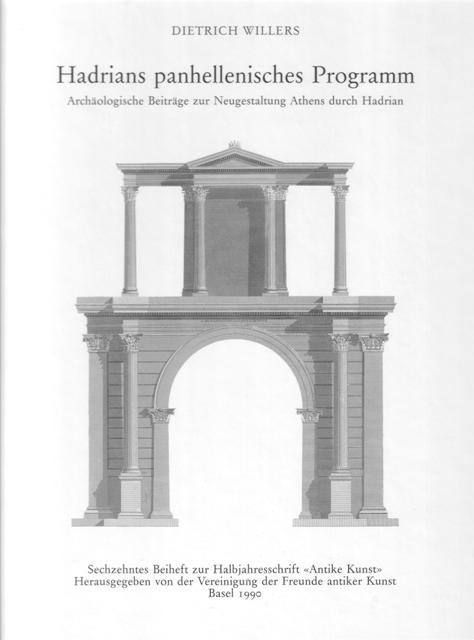Description
Archäologische Beiträge zur Neugestaltung Athens durch Hadrian
von Dietrich Willers
Nach einer langen Zeit der Stagnation erfuhr Athen durch Hadrian ab 120 nach Chr. eine vielfältige Wiederbelebung und städtebauliche Neugestaltung. Eine Neuinterpretation der erhaltenen hadrianischen Architektur, der geringen Reste der Bauausstattung und Skulpturen sowie der erhaltenen Inschriften zeigt, dass nicht allgemeine philhellenische Sympathien den Kaiser zu seinem Wirken in und für Athen veranlassten, sondern dass er mit der Neugestaltung der Stadt präzise politische Absichten verfolgte. Das neugegründete «Panhellenion» sollte ein Instrument dazu werden, den griechisch sprechenden Osten des Reiches an den lateinischen Westen anzubinden. Athen wurde als Vorort der neuen Institution ausersehen, die dem Auseinanderfallen der beiden Reichshälften entgegenwirken sollte. Das Zentrum der Planung befindet sich im Heiligtum des olympischen Zeus im Osten der Stadt, dem «Olympieion», und nicht wie die neueren Untersuchungen der Forschung dies wollen – im Gebiet der Hadriansbibliothek und der Agora. Den Schlüssel zur Deutung liefert das Verhältnis des sogenannten Hadriansbogens zum Olympieion und der panhellenische Kontext dieses Bogens in Eleusis. Die Interpretation wird von Abbildungen auf Tafeln – darunter auch Erstpublikationen und ungewöhnliche Blicke auf bekannte Bauten – Plänen und neuen Bauaufnahmen begleitet.
After a long period of stagnation, Athens was revitalized after 120 A. D. by the Emperor Hadrian, who restructured the city and endowed it with a number of new buildings. Through a fresh interpretation of the preserved remnants of Hadrianic architecture and sculpture and of the extant inscriptions, the author shows that it was not general sympathy or philhellenist leanings which led Hadrian to concern himself with Athens, but rather that he had precise political objectives in view. The ‘Panhellenion’ was founded as a means of attaching the eastern, Greek-speaking part of the Empire to the Latin West. Athens was designated as capital of this new institution, whose function was to keep the two halves of the Empire from falling apart. The central planning emanated not from the area of the Library of Hadrian or of the Agora, as recent studies have asserted, but from the ‘Olympieion’, the sanctuary of Zeus in the eastern part of the city. The key evidence is provided by the so-called Arch of Hadrian, its position in regard to the Olympieion and the panhellenic context of the same arch in Eleusis. The interpretation is accompanied by plate illustrations – some of which are published here for the first time, while others provide unusual views of wellknown monuments -, plans and several drawings based on new measurements.
Athènes connaît dès 120 ap. J.-C., par l’action d’Hadrien, une renaissance dans de nombreux domaines qui fait suite à une longue période de stagnation. Elle vit également une rénovation urbanistique. Quelles sont les raisons qui poussent Hadrien à agir de la sorte? L’auteur propose une interprétation nouvelle fondée sur l’analyse de l’architecture, de la sculpture et des quelques vestiges d’habitations conservés de cette période. Il tient compte également des témoignages épigraphiques. Tout concourt à attribuer à l’empereur des intentions qui ne sont pas le fait d’un philhellénisme désintéressé. Au contraire, Hadrien agit en faveur du renouveau d’Athènes pour des motifs politiques bien précis. Ainsi, le «Panhellénion» nouvellement créé doit servir la cause de l’attachement à l’Ouest latin de la partie orientale de l’empire qui parle grec. C’est la ville d’Athènes qui a été choisie pour abriter cette institution destinée à s’opposer à la sécession des deux moitiés de l’empire. Le centre de la nouvelle planification est à placer dans l’Olympiéion, le sanctuaire de Zeus olympien situé à l’Est de la cité, et non pas, comme le voudraient certaines études récentes, dans le secteur de la bibliothèque d’Hadrien et de l’Agora. Le lien qui unit l’arc dit d’Hadrien et l’Olympiéion ainsi que le contexte panhellénique de cet arc à Eleusis sont les clés de l’argumentation de l’auteur. L’ouvrage illustré compte des documents inédits, des vues nouvelles, parfois inhabituelles, d’édifices connus, des plans et des photographies récentes.
108 Seiten/pages – 18 Textabb./pictures – 15 Bildtafeln/tables
ISBN 3-909064-16-7

